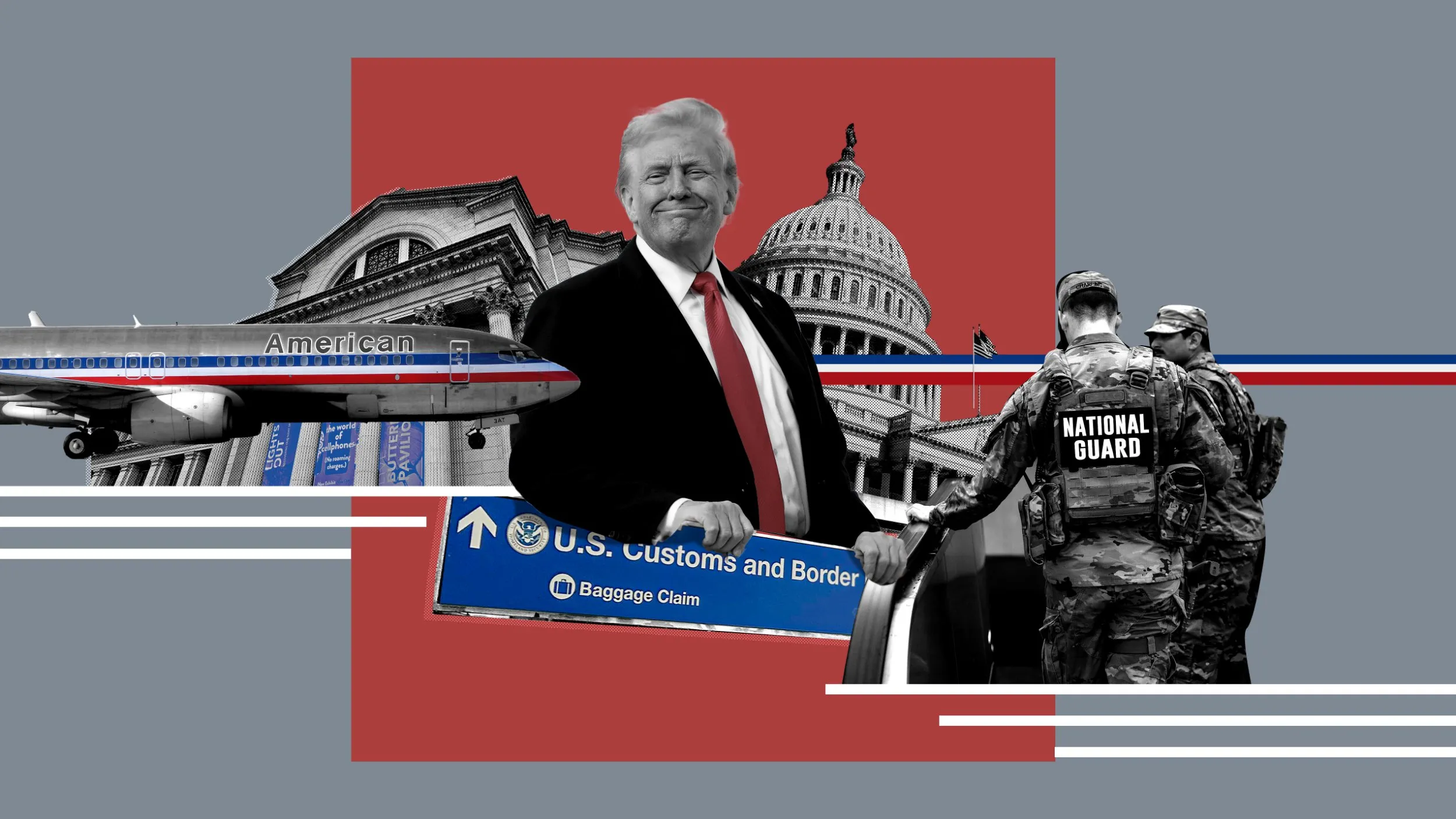Flights cancelled and landmarks in the dark — all the ways tourists will be affected by the US government shutdown
By Alice Murphy
Copyright metro

The first shutdown in nearly seven years will cause chaos for workers and tourists across America (Picture: Getty Images)
At one minute past midnight on 1 October in Washington DC, the shutdown of the US federal government began.
The first shutdown since 2018 came after a bitter standoff between Democrats and Republicans, which ended when Democratic lawmakers refused to vote for a Trump bill that they say will make it harder for Americans to afford healthcare.
Both parties are blaming each other, but polls show more Americans hold Republicans responsible.
The political gridlock is expected to put 40% of the federal workforce – about 750,000 people – on unpaid leave.
It also affects the operating status of sites such as museums, monuments and national parks.
Let’s look at how the shutdown will impact tourists across the US.
What is a shutdown?
A shutdown happens when Congress does not agree on a budget. This means that parts of the federal government must close until a spending plan is approved.
@metrouk The US government has shut down after Republicans and Democrats failed to agree on a funding package. Donald Trump had threatened to lay off ‘a lot of people’ as a result of the shutdown. This shutdown is the first since the end of 2018. #us #usgovernment #donaldtrump #democrats ♬ original sound – Metro – Metro
It might feel like a random time of year, but shutdowns tend to happen in October because the US government’s fiscal year runs from October 1 to September 30.
During a shutdown, ‘non-essential’ federal services are halted or reduced, and many government employees are placed on unpaid leave.
In this case, the Congressional Budget Office (CBO) estimates around 750,000 workers could be affected each day.
Essential employees – such as border protection officers, law enforcement, military service members and air traffic controllers – are required to keep working, often without pay, until funding is restored.
How long will it last?
That’s anyone’s guess. But we can look to history for an idea.
The current budget process was established in 1976. Since then, there have been 20 funding gaps – where Congress misses the deadline to pass a budget or a stopgap spending bill – resulting in 10 shutdowns.
The last shutdown, during Trump’s first term in December 2018, occurred after the Democrats opposed the president’s request for $5 billion in funding for a wall on the US-Mexico border.
That shutdown was the longest in history, lasting 35 days from December 22, 2018 to January 25, 2019.
The shutdown is the second of Trump’s two presidential terms (Picture: EPA)
As is the case with every shutdown since the 1990s, this one was resolved after Congress passed a continuing resolution, which provides short-term funding while the details of longer term funding are ironed out.
What caused the current shutdown?
This time, Democrats and Republicans couldn’t agree to pass a bill funding government services into October and beyond.
The Democrats say the proposed bill would have made healthcare unaffordable for ordinary Americans.
They are calling for an extension of tax credits – which are set to expire – that make health insurance cheaper for millions, and the restoration of funding to Medicaid that was cut by Trump.
How could this affect UK travellers in the US?
The Electronic System for Travel Authorisation, which is used by most British holidaymakers and business travellers in the US, is still operating.
British passport holders can still apply as normal.
Remember, though, that the fee for this visa has just doubled, rising from $21(£15.67) to $40 (£29.85) on the last day of September.
Meanwhile, Americans planning to travel abroad could be impacted by delays.
US passport agencies have warned that it could take longer than usual to process travel documents.
Did you know? You can clear US immigration in Ireland
There’s something about passing through immigration when you land at JFK that makes you wonder if you’ve accidentally smuggled 30 kilos of coke into your hand luggage.
But international travellers arriving from a select group of airports, including Ireland’s Dublin and Shannon, breeze through customs — without an American passport.
That’s because the Irish airports are two of 15 in the world that offer US Customs and Border Protection (CBP) Preclearance, which allows travellers to clear US immigration – and the headache that comes with it – before they board.
Read the full story from our Irish Travel Editor here.
Tourist attractions
As we’ve mentioned, the shutdown means the government must stop paying staff for all duties that are deemed non-essential.
Among several other things, this means that tourist attractions and facilities will be closed.
Any sites run by the National Park Service are likely to be among the worst impacted, because two-thirds of NPS staff will be stood down.
Although outdoor areas such as park roads, trails, and memorials might still be accessible, many facilities will be closed for health and safety reasons, as they cannot be properly maintained without staff.
Protesters march at the US Capitol Building on Capitol Hill on September 2, 2025, as lawmakers return from summer recess (Picture: Getty Images)
During the last shutdown, the Trump administration made the decision to leave parks open, with few to no federal workers there to staff them.
This led to vandalism, as visitors drove through protected landscapes, looted historical sites, and littered, according to park advocates.
The Smithsonian in Washington DC, which bills itself as the world’s greatest museum complex, said its venues – including the National Zoo – will remain open until Monday, October 6, using funding from recent years.
After that, what happens is unclear.
A geologist cleans litter at Yellowstone National Park, which spans Wyoming, Montana and Idaho (Picture: SWNS)
Popular attractions, including the Library of Congress and the Capitol Visitor Center, are already closed.
The National Archives at the JFK Presidential Library in Boston has said all events are cancelled ‘until further notice’.
One of the most cherished monuments in America, the Statue of Liberty, may also close. New York Govenor Kathy Hochul warned the state would not step in to keep the lights on as it did in 2018.
‘Today, the torch she holds — as a beacon to others, a symbol — could literally go dark,’ she said on the shutdown’s first day.
‘Not because of an act of God or a horrific storm, flood or hurricane. But literally because Donald Trump and Republicans in Washington forced a government shutdown.’
San Francisco’s iconic Alcatraz Island closed temporarily on October 1, but reopened on October 2.
In Seattle, the shutdown has led to the temporary closure of the Klondike Gold Rush National Historical Park, impacting locals and tourists alike.
Amtrak trains, which receives public funding but operates as an independent agency, will continue to run as normal.
America’s most iconic landmark, the Statue of Liberty, may also close (Picture: Getty Images)
The US Travel Association, which represents the travel industry, issued a stark warning about the impact of the shutdown.
‘The travel economy is at risk of losing $1 billion a week due to disruptions in air and rail travel and the closure of national parks and museums.’
Ports of entry into the country are expected to stay open for international travellers, according to the Department of Homeland Security’s contingency plan.
But a federal shutdown could cause transport chaos, from cancelled flights to long delays.
This is because air traffic controllers could decide to stay at home instead of working for free.
Air traffic controllers and about 50,000 Transportation Security Administration (TSA) employees who staff airport checkpoints are among those who would be required to keep working but would not be paid.
During the last shutdown nearly seven years ago, hundreds of flights were grounded or delayed as air traffic controllers and security checkpoint staff increasingly called in sick.
What have airlines said about the shutdown?
Airlines and aviation industry organisations have warned of widespread disruption.
The trade body Airlines For America said: ‘The system may need to slow down, reducing efficiency.
‘When federal employees who manage air traffic, inspect aircraft and secure our nation’s aviation system are furloughed or working without pay, the entire industry and millions of Americans feel the strain.’
Disruption is expected at New York’s JFK Airport (Picture: Getty Images)
Routes operated by Delta Airlines, American Airlines, United Airlines, and Southwest Airlines are all expected to be affected.
The FAA said that under its shutdown plan released in March, it would not be able to conduct air traffic controller hiring or field training of air traffic controllers.
Transportation Secretary Sean Duffy said on Friday he was concerned a shutdown could jeopardise air traffic training and the modernisation effort.
What has the UK Foreign Office said about travelling to the US?
Nothing, yet. The FCDO has not updated its travel advice for America since August 1.
Is it safe to travel to the US?
The UK Foreign Office is advising travellers to exercise normal safety precautions in the US.
That includes avoiding locations where demonstrations and protests are occurring.
https://www.instagram.com/p/DPQ0l_8CB3w/?hl=en
Law enforcement in the United States remains unaffected for now. The military will remain at their posts and National Guard troops will continue to work.
If you’re travelling through another country on your way to or from the US, the Foreign Office reminds you to check the entry requirements for that country.
Many countries will only allow entry if you have at least six months’ validity remaining on your passport.
If I cancel my trip, do I get my money back?
In a word, no.
Most package holidays to the US, and of course all independently organised trips, will not qualify for free amendment or cancellation.
The shutdown does not give you the right to cancel or postpone.



